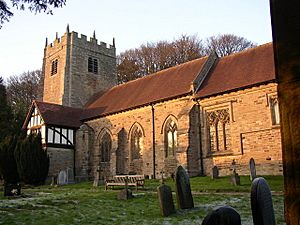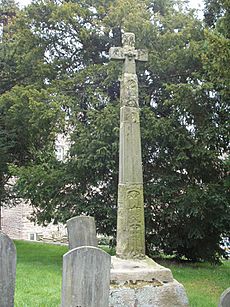St Wilfrid's Church, Halton-on-Lune facts for kids
Quick facts for kids St Wilfrid's, Halton |
|
|---|---|
 |
|
| Lua error in Module:Location_map at line 420: attempt to index field 'wikibase' (a nil value). | |
| OS grid reference | SD 49896 64722 |
| Location | Halton, Lancashire |
| Country | England |
| Denomination | Anglican |
| History | |
| Status | Parish church |
| Architecture | |
| Functional status | Active |
| Heritage designation | Grade II |
| Designated | 4 October 1967 |
| Architect(s) | Paley and Austin |
| Completed | 1877 |
| Administration | |
| Deanery | Tunstall |
| Archdeaconry | Lancaster |
| Diocese | Blackburn |
| Province | York |
St Wilfrid's Church is a special old church in the village of Halton-on-Lune, Lancashire, England. It's an Anglican church, which means it's part of the Church of England. People still use it for services today. Halton might have been home to an ancient Anglo-Saxon church called a minster a long time ago.
The church's tall tower was built in the 1500s. Most of the rest of the church was built much later, between 1876 and 1877. This work was done by a famous architecture company called Paley and Austin. St Wilfrid's Church is considered a very important building. It is listed as a Grade II building on the National Heritage List for England. This means it's protected because of its history and special design.
Contents
Church History
Before the Norman conquest of England in 1066, Halton was a big estate owned by Earl Tostig Godwinson. There is proof that Christians worshipped in Halton even back then. It's likely there was an Anglo-Saxon minster, which was an important church.
Some people think the church might have a connection to a bishop named Wilfrid, who lived around 633 to 709 AD. By the year 1252, the church was definitely named after Saint Wilfrid. For many years, the local lord of the manor had the right to choose the church's priest.
The church's tower was built in the 1500s. The rest of the church was rebuilt in 1792. However, the church you see today (except for the tower) was built between 1876 and 1877. This was done by the architects Paley and Austin from Lancaster. The churchyard, which is the area around the church, was made bigger in 1872, 1901, and again in 1907.
Church Design and Features
Outside the Church
St Wilfrid's Church is made from yellow sandstone rocks and has red tile roofs. It has a main area called a nave, with the tower at the west end. There's also a north aisle (a side section) and a chancel (the area near the altar) at the east end.
On the south side of the nave, there's a two-story porch. The top part of the porch has special wooden framing. The tower is about 55 feet (16.8 meters) tall. Its corners have strong supports called buttresses. The top of the tower has a crenellated parapet, which looks like the top of a castle wall, with pointy decorations called pinnacles. A spiral staircase is hidden in the north-east corner. The tower also has openings with louvres for the bells, which help the sound travel.
The windows on the south side of the church have a style called "Decorated." They feature different patterns of stone work, known as tracery.
Inside the Church
The tower inside is about 12 feet 10 inches (3.9 meters) square. It holds three bells. Inside the tower, you can still see some pieces of Anglo-Saxon art, like old stone carvings. The main part of the church, the nave, is about 49 feet 9 inches (15.2 meters) long and 18 feet 9 inches (5.7 meters) wide. You enter the nave from the tower through a curved archway. The nave has four sections, called bays.
The chancel, where the altar is, measures about 25 feet (7.6 meters) by 18 feet (5.5 meters). It includes a room for the organ and a vestry, which is where the clergy get ready.
The church has beautiful stained glass windows. Some of these windows show images of Joan of Arc and Saint George. These were made by a company from Lancaster called Shrigley and Hunt. There is also a baptismal font (a basin for baptisms) that dates back to 1848.
Churchyard Features
The churchyard surrounds the church, especially on the south and east sides. It has sandstone gates and gateposts from the late 1700s. A special covered gateway called a lychgate was added in 1907. To the north, there's a two-level burial vault built into a hill. This is where the Bradshaw family is buried.
South of the church, you'll find an amazing Anglo-Saxon high cross. This cross is made of carved sandstone. It has a base about 1.5 meters by 1.4 meters, with a tall shaft and a cross head. Carvings from the 1000s on the shaft tell the story of Sigurd, a hero from old legends.
About 4 meters south-east of the porch, there's a sundial from the 1600s. Its sandstone base has an inscription that says, "For Saint Wilfrite Church at Halton 1635. Pereunt et imputantur." This Latin phrase means "They perish and are accounted to us," which is a reminder that time passes quickly.
Church Importance and Management
St Wilfrid's Church was officially recognized as a Grade II listed building on October 4, 1967. Grade II is the lowest of the three grades, but it still means the building is very important. Experts in architecture, Pevsner and Hartwell, said in 2009 that the church is "easily recognizable" as a work by Paley and Austin. The 18th-century gates, gateposts, and the sundial are also separately listed as Grade II. The Anglo-Saxon high cross is so important that it's been named a scheduled monument, meaning it's a protected historical site.
St Wilfrid's is an active Church of England parish church. It is part of the Diocese of Blackburn, which is in the Province of York. It belongs to the archdeaconry of Lancaster and the Deanery of Tunstall. St Wilfrid's shares its priest and resources with St Saviour's Church in Aughton and St Luke's Church in Slyne-with-Hest.
See also
- Listed buildings in Halton-with-Aughton
- List of ecclesiastical works by Paley and Austin
- Scheduled monuments in Lancashire


